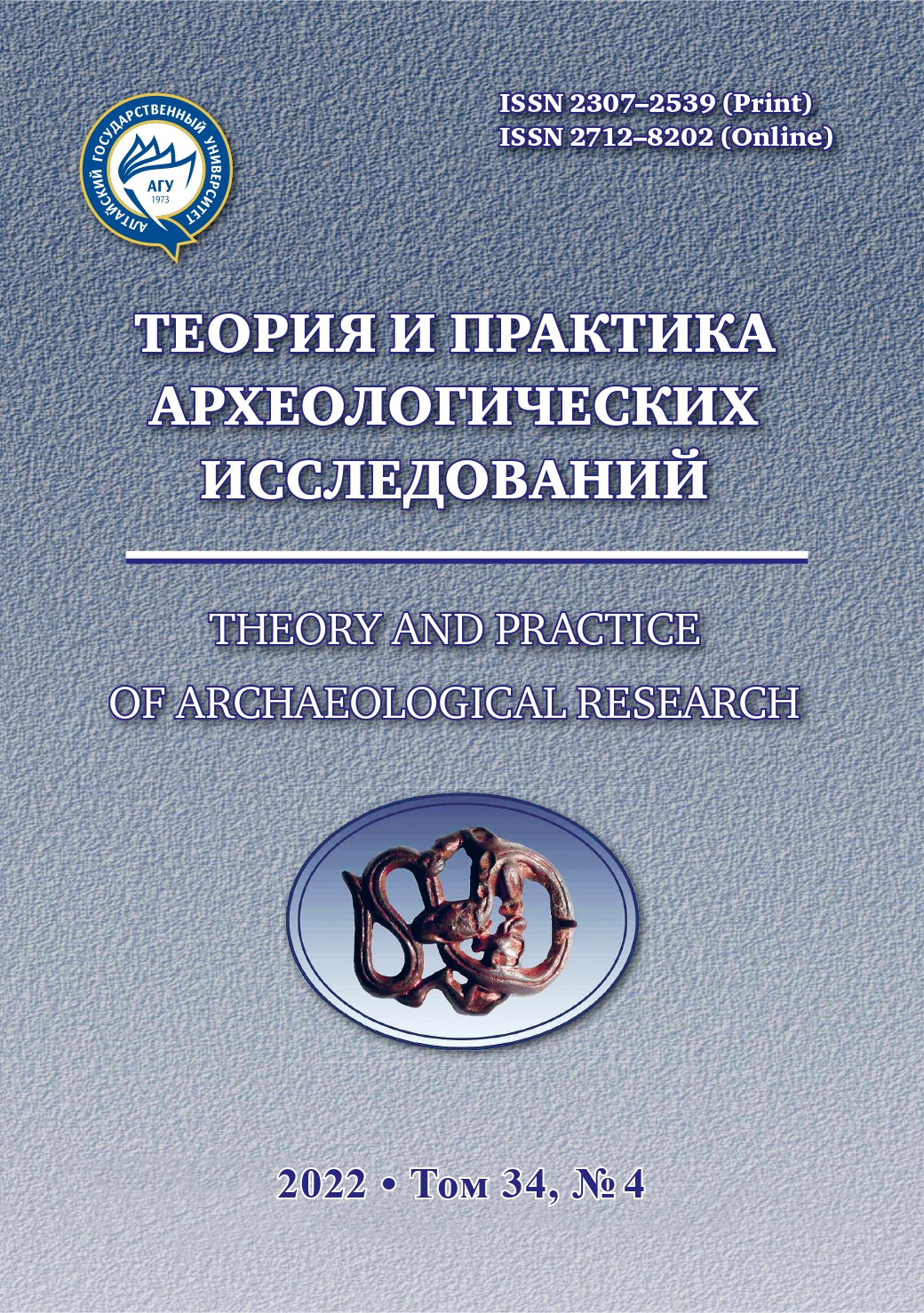DATING OF THE IRON BUCKLES, PLAQUES ON THE BELT AND HOOKS OF THE MIDDLE AGES PERIOD FROM THE MIDDLE VOLGA REGION (BASED ON THE MATERIALS OF THE OSTOLOPOVO SETTLEMENT IN TATARSTAN)
Abstract
The article deals with iron buckles, plaques on the belt and hooks from the excavations of the Ostolopovo settlement in Tatarstan. It existed in the 11th — 12th centuries. The Ostolopovo settlement was one of the settlements in the central part of the Volga Bulgaria, located on the way from the center of the state to the Kama River, which was the most important trade route of Bulgaria. The settlement was investigated in 1969 and 1997–2013. It is distinguished by a unique stratigraphy, which is associated with the peculiarities of the functioning of the settlement. This settlement existed for a short time — from the end of the 10th century to the second half of the 12th century. The heyday of the settlement fell on the second half of the 11th — the fi rst half of the 12th century. During the excavations, 40 iron buckles, plaques on the belt and hooks were found. The peculiarity of these artifacts was that they were made according to samples that came to the Bulgars from Southern Siberia. Their prototypes were items of the Askiz archaeological culture. Such fi nds are typical for the Bulgar archaeological sites of the pre-Mongol period. In addition, Bulgar copies of Askiz originals spread beyond the borders of Volga Bulgaria. They are found among the medieval Mari, Udmurts, Permians, Mordovians. Th erefore, finding out the time of existence of such items is very important for dating the archaeological materials of the entire Volga-Kama region. Well-dated layers of the Ostolopovsky settlement allow this to be done. The analysis of the finds showed that they begin to occur in the third stratigraphic layer, which dates back to no earlier than the middle — second half of the 11th century. It contained a few items from a belt with an iron buckle and plaques on the belt that adorned it. Most of the finds come from the second layer, which was formed from the turn of the 11th–12th centuries until the second third of the 12th century. They are notable for their improved form design, which also included decoration of the surface with ornaments and possibly silver inlay. Finds of this type are no longer found in the upper horizon of the second layer. Thus, the period of the use of the Bulgar derivatives of Askiz products in the Ostolopovo settlement is the second half of the 11th — the second third of the 12th century. According to stratigraphy, the greatest use of such artifacts was in the first half of the 12th century.
Downloads
Metrics
References
Belorybkin G. N. Zolotarevka Settlement. St. Petersburg : IIMK RAN, 2001. 190 p. (In Russ.)
Belorybkin G. N. New Materials of the Zolotarevka Settlement. In: Archaeology of the East European Forest-Steppe.. Penza : Izd-vo PGPU, 2003. Pp. 410–432. (In Russ.)
Valiev R. R., Stepanov R. A. Balymer Settlement V: Results of Research in 2019. Arheologiya Evrazijskih Stepej = Archaeology of the Eurasian Steppes. 2021;3:24–42. (In Russ.). doi:10.24852/2587-6112.2021.3.24-42
Garustovich G. N. Bakalino Barrow Burial Ground of the Beginning of the 2nd Millennium AD in Bashkortostan. In: Middle Volga and Southern Urals: Man and Nature in Antiquity. Kazan : Fen, 2009. Pp. 197–212. (In Russ.)
Garustovich G. N., Ivanov V. A. Aznaevo-II Burial Mound of the 13th Century in the Forest-Steppe Zone of the Southern Urals. Ufimskij arkeologicheskij vestnik = Ufa Archaeological Bulletin. 2019;10:95–104. (In Russ.)
Ivanova M.G. Funeral Sites of the Northern Udmurts of the 11th–13th Centuries. Izhevsk : Izd-vo UIIYaL URO RAN, 1992. 184 p. (In Russ.)
Kazakov E. P. Bulgar Village of the 10th–13th Centuries in the Lower Reaches of the Kama. Kazan : Tatarskoe knizhnoe izd-vo, 1991. 176 p. (In Russ.)
Kokorina N. A. Pottery Forges of the Bilyar Hillfort. In: Medieval Archaeological Sites of Tataria. Kazan : IYaLI KFAN SSSR., 1983. Pp. 50–69. (In Russ.)
Kyzlasov I. L. Askiz Culture of Southern Siberia in the 10th- 14th Centuries. Moscow : Nauka, 1983. 128 p. (Collection of archaeological sources. Issue E3-18). (In Russ.)
Nabiullin N. G. Excavations in the Handicraft District of Dzhuketau (based on materials from excavation V, 1994). In: Problems of Ancient and Medieval Archaeology of the Volga-Kama Region. Kazan : Master-Layn, 1996. Pp. 101–126. (In Russ.)
Nigamaev A. Z. Bulgarian Cities of the Kama Region. Alabuga, Kirmen, Chally: the Originality of the Material Culture of the Population. Kazan : Izd-vo Kazanskogo universiteta, 2005. 228 p. (In Russ.)
Rudenko K. A. Th e Turkic World and the Volga-Kamie in the 6th –14th Centuries. Products of the Askiz Circle in the Middle Volga Tegion. Research and Catalogue. Kazan : Zaman, 2001. 256 p. (In Russ.)
Rudenko K. A. Iron Arrowheads in the 8th –15th Centuries from the Volga Bulgaria. Research and Catalogue. Kazan : Zaman, 2003. 512 p. (In Russ.)
Rudenko K. A. To the Question of the Bulgar Dwellings of the Pre-Mongolian Time (based on the materials of the Ostolopovo settlement in the Alekseevo region of the Republic of Tatarstan). In: The Middle Volga and the Southern Urals: Man and Nature in Antiquity. Kazan : Fen, 2009. Pp. 309–352. (In Russ.)
Rudenko K. A. Report on Archaeological Research in Tatarstan in 2008. Kazan, 2009a. In: Archive of IA RAS. F-1. R-1. No. 44189. 46 p., 117 il., 3 tab. (In Russ.)
Rudenko K. A. Results of the Study of the Ostolopovo Settlement in the Alekseevskiy District of the Republic of Tatarstan. Povolzhskaya arheologiya = The Volga River Region Archaeology. 2012;2:123–145. (In Russ.)
Rudenko K. A. Studies of VI Alekseevskiy and Murzikha Settlements in Tatarstan in 1992–1996. Kazan : ID “Kazanskaya nedvizhimost’”, 2015. 400 p. (In Russ.)
Rudenko K. A. Stratigraphy of the Ostolopovo Settlement in the 11th–12th Centuries in the Alekseevsky Region of Tatarstan. Arheologiya Evrazijskih Stepej = Archeology of the Eurasian steppes. 2017;1:296–319. (In Russ.)
Rudenko K. A. New Data on the Bulgar Dwellings of the Pre-Mongol Period (based on the materials of the Ostolopovo settlement in Tatarstan. Arheologiya Evrazijskih Stepej = Archeology of the Eurasian steppes. 2019;6:95–110. (In Russ.). doi: 10.244.11/2587-6112-2019 -00082
Rudenko K. A. On the Question of Dating the Ostolopovo Settlement in Tatarstan. Arheologiya Evrazijskih Stepej = Archeology of the Eurasian steppes. 2021;3:65–79. (In Russ.). doi: 10.24852/2587-6112.2021.3.65.79
Rudenko K. A. On the Features of the Material Culture of the Peoples of the Middle Volga and Cis-Urals in the 11th –12th Centuries. (Askiz Circle of Sntiquities). In: Penza Archaeological Collection. Issue 5. Penza : Institut regional’nogo razvitiya Penzenskoj oblasti, 2022. Pp. 163–190. (In Russ.)
Khalikov A. Kh., Sharifullin R. F. Caravanserai of Ancient Bilyar. In: Research of the Great City. Moscow : Nauka, 1976. Pp. 75–100. (In Russ.)
Khlebnikova T. A. Some Results of the Study of the Bulgar Sites of the Lower Kama Region. Sovetskaya arheologiyia = Soviet Archaeology. 1974;1:58–68. (In Russ.)
Shpolyansky S. V. Ferrous Metal Overlays from Medieval Sites of the Suzdal Opole. In: Archaeology of the Moscow Region. Issue 15. Moscow : IA RAN, 2019. Pp. 227–245. (In Russ.). doi: 10.25681/IARAS.2019.978-5-94375-272-8.227-245
Theory and Practice of Archaeological Research is a golden publisher, as we allow self-archiving, but most importantly we are fully transparent about your rights.
Authors may present and discuss their findings ahead of publication: at biological or scientific conferences, on preprint servers, in public databases, and in blogs, wikis, tweets, and other informal communication channels.
Theory and Practice of Archaeological Research allows authors to deposit manuscripts (currently under review or those for intended submission to ABS) in non-commercial, pre-print servers such as ArXiv.
Authors who publish with this journal agree to the following terms:
- Authors retain copyright and grant the journal right of first publication with the work simultaneously licensed under a Creative Commons Attribution License (CC BY 4.0) that allows others to share the work with an acknowledgement of the work's authorship and initial publication in this journal.
- Authors are able to enter into separate, additional contractual arrangements for the non-exclusive distribution of the journal's published version of the work (e.g., post it to an institutional repository or publish it in a book), with an acknowledgement of its initial publication in this journal.
- Authors are permitted and encouraged to post their work online (e.g., in institutional repositories or on their website) prior to and during the submission process, as it can lead to productive exchanges, as well as earlier and greater citation of published work (See The Effect of Open Access).








2.jpg)



